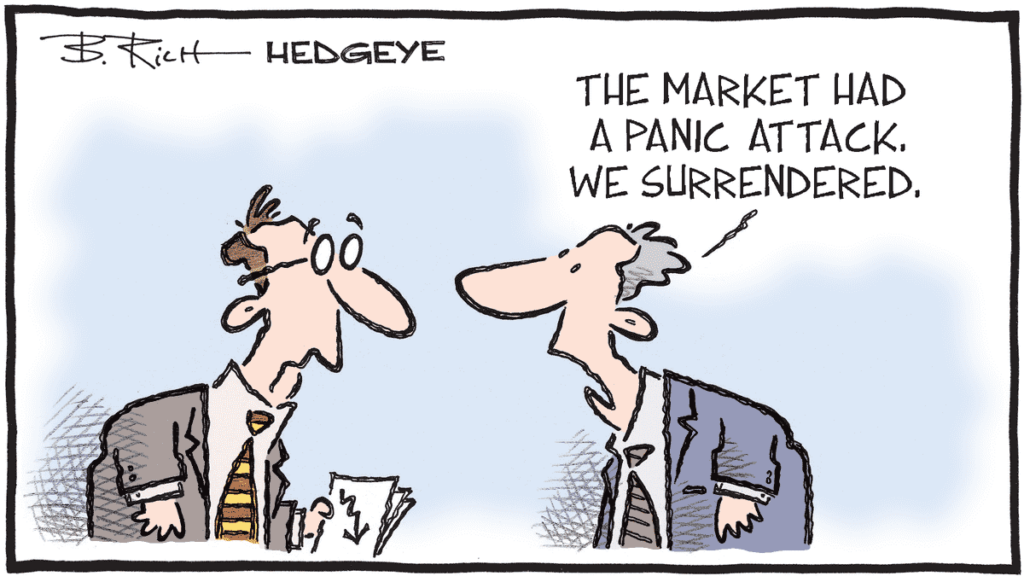
The week started in the red, as expected. However, not everyone was in the red—Americans still managed to pull off one of their signature REVERSALS. The shift from panic mode to “time to buy the dip” was brutally violent (once again). While Europe was licking its wounds, waiting for “Liberation Day,” the U.S. markets made a full 180-degree turn, closing with the biggest “recovery day” seen in three years. And all of this just 48 hours before an announcement of biblical proportions regarding tariffs. In summary, this is either the biggest scam of the century or an act of genius.
We’re Asking Questions but Finding No Answers
The hardest part of all this is understanding WHY the market suddenly flipped after hitting rock bottom. The European plunge isn’t much of a mystery—everyone understands that Europeans are terrified of the potential announcements from Donald Trump, given that they’re on the front lines. But in the U.S., considering the sheer fear hanging over Wall Street on Sunday night and Monday morning, it’s hard to justify a rebound of this magnitude.
Sure, one could argue that since the indices tested new short-term lows and technical breakdowns didn’t trigger massive sell-offs—AND it was also the last day of the quarter, with many taking the opportunity to clean up their portfolios and take profits on shorts—this could explain part of it. But the theory that “we’ve seen capitulation, so now I’m buying” seems a bit far-fetched. Yet, it’s out there—I read it this morning. The issue is that calling it capitulation when the VIX peaks at 24.80% seems premature.
Still, the fact remains that after hitting a low of 5,486—just a few points below the psychological and technical support level of 5,500 on the S&P 500—we bounced back as if it were already the day after Liberation Day, and as if Trump had ALREADY walked back his decisions.
End of the Quarter
Even though the U.S. market’s positive close caught many off guard, it doesn’t change the fact that this quarter was rough. The S&P 500 has lost 4.6% since January 1st, making this the worst quarter since early 2022. And yet, we had such HIGH HOPES at the start of the year with Trump’s return. But those hopes were quickly crushed by his enthusiastic use of tariffs.
Add to that a consumer base that’s starting to lose confidence—some even doubting everything. Throw in fears over Trump’s protectionist policies, and soon you’ll see strategists talking about stagflation or recession. I’m not making this up—read the Wall Street Journal, MarketWatch, or Barron’s, and you’ll find plenty of references to these scenarios. Just a short while ago, bringing up either of those terms would have gotten you sent straight to a psych ward.
It’s clear that investors, analysts, strategists, and even the guy fetching their coffee all have moods that shift faster than tariff rumors. The only thing left to hold onto is historical market data. And historically, “in general,” when we have a terrible first quarter, the second quarter is “generally” better. That’s reassuring.
We know finance isn’t an exact science, but still, it’s comforting. And in times of uncertainty, we all need a little reassurance—even if it only lasts three minutes.
Yesterday Again
So we witnessed a textbook REVERSAL, going from “we’re all going to die by Wednesday” to “but if we don’t, this is the buying opportunity of a lifetime.”
Let’s be real—when the Nasdaq drops 15% in six weeks, that’s a lot of bad news priced in. We already know the economy is slowing down. We know the job market isn’t great (even if no one likes to admit it). We know the fight against inflation isn’t ending anytime soon. And we know that if the Fed cuts rates three times this year, that would be like paradise. Some are even betting on a recession or stagflation.
So unless Trump slaps 100% tariffs on the entire planet, we can assume the market has already priced in most of the bad news.
The proof? It even anticipated the post-tariff-announcement rebound before Wednesday’s announcement.
Let’s hope it holds.

However, it’s still worth mentioning three events that have nothing to do with Tariffs:
Several analysts are getting anxious as the release of Tesla’s delivery figures approaches. With just two days to go before the Q1 delivery report, analysts are revising their estimates downward. Between tariffs weighing on imported parts, controversies surrounding Musk, and the booming sales of “I bought a Tesla before Musk lost his mind” stickers—not to mention plunging sales in Germany and France—there’s reason to worry. Yesterday, Stifel slashed its delivery forecasts by 23%, with Baird and Wedbush following suit. Even the most bullish of bulls, Dan Ives, is expecting a “very soft” quarter. Yet, all remain “positive in the medium term,” as if searching for a glimmer of hope in the headlights. The consensus is at 377,000 cars delivered, but the market would be happy with just “360,000.” Any lower, and Musk’s seat might start heating up. The stock is down 37% since January 1st, with an average price target of $358—offering a potential 40% upside, but it takes guts. Today, though, fear is taking over. Meanwhile, Musk continues to walk the tightrope between visionary genius and political liability.
There’s also drama in the biotech sector, as Peter Marks, director of the FDA’s Center for Biologics Evaluation and Research, is reportedly about to be shown the door. Marks had supported programs that accelerated the development of treatments for rare diseases and gene therapies during his tenure and played a key role in the development of COVID-19 vaccines. Without his backing, the entire biotech sector went into panic mode. Moderna took a 9% hit on the news and didn’t even benefit from the market rebound. This is yet another ripple effect of Trump’s policies, no doubt.
And then, a little IPO excitement: Newsmax, the fourth-highest-rated cable news channel in the U.S. and somewhat conservative in the Trumpian vein, went public yesterday. Priced at $10, it closed at $83.50—up 735%—and gained another 17% after hours. But no, there’s absolutely no manipulation here. The IPO was tiny, and the floating shares were laughably low. This one’s going to be fun to watch.
Asia and the Market Outlook for Tomorrow
This morning in Asia, markets are holding back, waiting for more clarity on tariffs. The Nikkei is motionless, as is China, while Hong Kong is up 1%. Oil is at $71.63, surging after Trump threatened to slap tariffs on Russian oil. Gold keeps climbing as if nothing is happening, trading at $3,175 per ounce, while Bitcoin is in a coma at $83,000.
But let’s return to the week’s main topic: Liberation Day, or, in other words, Trump 2.0’s announcement of reciprocal tariffs. I’ve tried to piece together everything we know so far—it’s best to be as informed as possible to make sense of it.
So, it’s official: this Wednesday, Donald Trump will have his “Churchill moment” — except instead of landing in Normandy, he’ll simply unleash a barrage of tariffs on anything that moves, is imported, rolls, sparkles, or fizzes from abroad. For him, it’s “Liberation Day.” For markets, businesses, and consumers, it’s looking more like the beginning of the tariff battle of the year. Maybe even the decade.
What do we know? Not much. What do we suspect? A lot. And what do we fear? Even worse.
The Plan—If There Ever Was One
The initial idea, according to inside sources, was to impose targeted tariffs on around fifteen countries, nicknamed the “Dirty 15.” A neat, precise, surgical approach—very Dirty Harry in spirit. But in Trump’s world, well-crafted scripts rarely last more than 48 hours.
On Sunday night, aboard Air Force One, Trump dropped a bombshell:
“Why 15 countries? Let’s start with everyone and see how it goes.”
Since then, speculation has run wild. The Wall Street Journal is already reporting that an across-the-board 20% tariff on all imports to the U.S. is on the table—no exceptions. Everyone in the same basket. The original “you tax me, I tax you” concept has apparently morphed into “shoot first, ask questions later.” Dirty Harry, I told you…
The Numbers That Make Heads Spin
Peter Navarro, Trump’s top economic advisor, has started throwing out figures:
$100 billion in revenue from tariffs on imported cars
$600 billion per year with the new tariffs
$6 trillion over 10 years
Jackpot! The Trump administration is about to hit the bank. Except… yeah, except the economists are raising an eyebrow—or two. Because the more you tax, the less you import, which means the less revenue you collect. And if foreign products become too expensive, Americans will buy less. And if they buy less, corporate margins shrink, profits nosedive, markets tank… you get the picture.
Businesses in Logistics Panic Mode
On the ground, it’s controlled chaos. Companies are scrambling to stock up before the deadline. The result? Ports are overflowing, warehouses are bursting, and no one really knows what’s taxed, what’s not, and what will be in three days. A logistical nightmare.
Meanwhile, customs officials are playing a game of “yes, no, maybe” with exemption forms, and consumers are reacting their own way: boycotts. In Canada, summer travel to the U.S. is down more than 70%. Europe is seeing a similar trend. Maybe this is the year to visit the U.S.—at least it’ll be quiet.
Morale Plunges, Economy Wobbles
A survey by the National Association of Manufacturers shows that 76% of industrial leaders now cite trade uncertainty as their primary concern—up from just 36% six months ago. Investments are being halted, hiring plans are being shelved, production strategies are being revised.
And all this while the Trump administration is selling these tariffs as a booster for American industry. Ironic, no? Economists are now openly discussing stagflation—that nasty cocktail of slow growth and soaring inflation.
And then there’s China. China isn’t laughing. Already struggling to climb out of a slump, it’s now facing a 35% tariff and could retaliate by devaluing the yuan. That would make Chinese goods more competitive but would also escalate trade tensions and hurt American exporters in the process. The classic snake-eating-its-tail scenario—2025 edition.
At this point, the biggest risk seems to be a domino effect:
Reduced consumer spending
Shrinking profit margins
Widespread uncertainty
Reduced investment
Growing distrust
A global sell-off
Recession, market crash, cascading bankruptcies—you name it.
Wednesday’s Big Showdown
Trump is hoping to sell us a dream with his “Liberation Day.” But beneath the verbal fireworks, the reality is an explosive mix of economic uncertainty, a blurry strategy, a chain reaction of consequences, and markets under pressure.
It might work. Maybe.
Or it might blow up in his face—taking everything else down with it.
But beyond the economics, the real question is: HOW WILL THE MARKET REACT? Because at the end of the day, on Wall Street, it’s all about this year’s performance.
Until, of course, Main Street takes to the streets.
Today’s Expectations, Tomorrow’s Reality
The good news? Tomorrow, we’ll finally have some clarity—less speculation, more facts.
Until then, we have a full slate of economic data:
Manufacturing PMIs in France, Germany, and Europe
European CPI
ISM Manufacturing PMI and JOLTS in the U.S. (expecting 7.69 million job openings)
It’s going to be fun.
For now, uncertainty reigns, and no one trusts yesterday’s rebound. Futures are down 0.42%.
And I guarantee this report is 100% April Fools’-free—even if, at times, it doesn’t feel that way.
Have a great day, and see you tomorrow to brace for the impact.

